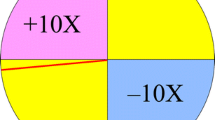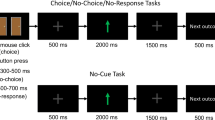Abstract
An abundance of evidence indicates that action selection is guided, at least in certain contexts, by anticipation of action outcomes. In one particularly clear demonstration of this principle, Bechara and colleagues, studying a gambling task, observed phasic skin conductance responses just prior to actions associated with a relatively high risk of monetary loss (Bechara et al. in J Neurosci 19:5473–5481, 1999; Bechara et al. in Science 275:1293–1295, 1997; Bechara et al. in Cereb Cortex 6:215–225, 1996). In the present work, we tested for the same effect in a paradigm where choices resulted not in differential monetary outcomes, but in differential requirements for subsequent mental effort. In two experiments, we observed an anticipatory skin conductance response prior to actions resulting in a high level of cognitive demand. This finding indicates that requirements for effortful cognitive control are anticipated during action selection. We argue, based on convergent evidence, that such anticipation may not only trigger preparation; it may also play a direct role in effort-based decision-making.


Similar content being viewed by others
References
Allport, G. W. (1954). The Nature of Prejudice. New York: Addison Wesley.
Andreassi, J. L. (2000). Psychophysiology: Human behavior and physiological response. New Jersey: Lawrence Erlbaum Associates.
Balle, M. (2002). La loi du moindre effort mental: Les representations mentales. Sciences Humaines, 128, 36–39.
Baroody, A. J., & Ginsburg, H. P. (1986). The relationship between initial meaningful and mechanical knowledge of arithmetic. In J. Hiebert (Ed.), Conceptual and procedural knowledge: The case of mathematics (pp. 75–112). Hillsdale: Lawrence Erlbaum Associates.
Bechara, A., Damasio, H., Damasio, A. R., & Lee, G. P. (1999). Different contributions of the human amygdala and ventromedial prefrontal cortex to decision-making. Journal of Neuroscience, 19, 5473–5481.
Bechara, A., Damasio, H., Tranel, D., & Damasio, A. R. (1997). Deciding advantageously before knowing the advantageous strategy. Science, 275, 1293–1295.
Bechara, A., Tranel, D., Damasio, H., & Damasio, A. R. (1996). Failure to respond autonomically to anticipated future outcomes following damage to prefrontal cortex. Cerebral Cortex, 6, 215–225.
Botvinick, M. (2007). Conflict monitoring and decision making: Reconciling two perspectives on anterior cingulate function. Cognitive, Affective and Behavioral Neuroscience, 7, 356–366.
Botvinick, M. M., Cohen, J. D., & Carter, C. S. (2004). Conflict monitoring and anterior cingulate cortex: An update. Trends in Cognitive Sciences, 8(12), 539–546.
Botvinick, M., & Rosen, Z. (2007). Is mental effort aversive? Some behavioral and psychophysiological evidence. Paper presented at the Cognitive Neuroscience Society Annual Meeting.
Botvinick, M., Rosen, Z., & McGuire, J. C. (2008). Action selection based on anticipated cognitive demand: A test of “the law of least mental effort” (submitted).
Brown, J. W., & Braver, T. S. (2007). Risk prediction and aversion by anterior cingulate cortex. Cognitive, Affective and Behavioral Neuroscience, 7, 266–277.
Buchel, C., Morris, J., Dolan, R. J., & Friston, K. J. (1998). Brain systems mediating aversive conditioning: An event-related fMRI study. Neuron, 20, 947–957.
Camerer, C. F., & Hogarth, R. M. (1999). The effects of financial incentives in experiments: A review and capital-labor-production framework. Journal of Risk and Uncertainty, 19, 7–42.
Carter, C. S., & Van Veen, V. (2007). Anterior cingulate cortex and conflict detection: An update of theory and data. Cognitive, Affective and Behavioral Neuroscience, 7, 367–379.
Christenfeld, N. (1995). Choices from identical options. Psychological Science, 6, 50–55.
Damasio, A. R. (1996). The somatic marker hypothesis and the possible functions of the prefrontal cortex. Philosophical Transactions: Biological Sciences, 351, 1413–1420.
Fowles, D. C. (1980). The three arousal model: Implications of Gray’s two-factor learning theory for heart rate, electrodermal activity and psychopathy. Psychophysiology, 17, 87–104.
Fowles, D. C. (1988). Psychophysiology and psychopathology: A motivational approach. Psychophysiology, 25, 373–391.
Fredrikson, M., Furmark, T., Olsson, T., Fischer, H., Andersson, J., & Langstrom, B. (1998). Functional neuroanatomical correlates of electrodermal activity: A positron emission tomographic study. Psychophysiology, 35, 179–185.
Gendolla, G. H., & Richter, M. (2005). Ego involvement and effort: Cardiovascular, electrodermal, and performance effects. Psychphysiology, 42, 595–603.
Hull, C. L. (1943). Principles of behavior. New York: Appleton-Century.
Johansen, J. P., & Fields, H. L. (2004). Glutamatergic activation of anterior cingulate cortex produces an aversive teaching signal. Nature Neuroscience, 7, 398–403.
Kim, H., Shimojo, S., & O’Doherty, J. (2006). Is avoiding an aversive outcome rewarding? Neural substrates of avoidance learning in the human brain. PLOS Biology, 4, 1453–1461.
Koyama, T., Tanaka, Y., & Mikami, A. (1998). Nociceptive neurons in the macaque anterior cingulate activate during anticipation of pain. Neuroreport, 9, 2663–2667.
Loftus, G. R., & Masson, M. E. J. (1994). Using confidence intervals in within-subject designs. Psychonomic Bulletin and Review, 1, 476–490.
Mathias, C. J., Josephs, O., O’Doherty, J., Zanini, S., Dewar, B. K., Cipolatti, L., et al. (2003). Human cingulate cortex and autonomic control: Converging neuroimaging and clinical evidence. Brain, 125, 2139–2152.
McGuire, W. J. (1969). The nature of attitudes and attitude change. In G. Lindzey & E. Aronson (Eds.), The handbook of social psychology (Vol. 3, pp. 136–314). Reading: Addision-Wesley.
Monsell, S. (2003). Task switching. Trends in Cognitive Sciences, 7(3), 134–140.
Naccache, L., Dehaene, S., Cohen, L., Habert, M. O., Guichart-Gomez, E., Galanaude, D., et al. (2005). Effortless control: Executive attention and conscious feeling of mental effort are dissociable. Neuropsychologia, 43(9), 1318–1328.
Nagai, Y., Critchley, H. D., Featherstone, E., Trimble, M. R., & Dolan, R. J. (2004). Activity in ventromedial prefrontal cortex covaries with sympathetic skin conductance level: Physiological account of a “default mode” of brain function. NeuroImage, 22.
Pecchinenda, A., & Smith, C. A. (1996). The affective significance of skin conductance activity during a difficult problem-solving task. Cognition and Emotion, 10, 481–503.
Rosch, E. (1999). Principles of categorization. In E. Margolis & S. Laurence (Eds.), Concepts: Core readings. Cambridge: MIT Press.
Rudebeck, P. H., Walton, M. E., Smyth, A. N., Bannerman, D. M., & Rushworth, M. F. S. (2006). Separate neural pathways process different decision costs. Nature Neuroscience, 9, 1161–1168.
Rushworth, M. F. S., Walton, M. E., Kennerley, S. W., & Bannerman, D. M. (2004). Action sets and decisions in the medial frontal cortex. Trends in Cognitive Sciences, 8, 410–417.
Solomon, R. L. (1948). The influence of work on behavior. Psychological Bulletin, 45, 1–40.
Tranel, D., & Damasio, H. (1994). Neuroanatomical correlates of electrodermal skin conductance responses. Psychophysiology, 31, 427–438.
Walton, M. E., Kennerley, S. W., Bannerman, D. M., Phillips, P. E. M., & Rushworth, M. F. (2006). Weighing up the benefits of work: Behavioral and neural analyses of effort-related decision making. Neural Networks, 19, 1302–1314.
Wright, R. A. (1996). Brehm’s theory of motivation asa model of effort and cardiovascular response. In P. M. Gollwitzer & J. A. Bargh (Eds.), The Psychology of Action (pp. 424–453). New York: Guilford Press.
Wright, R. A., & Brehm, J. W. (1989). Energization and goal attractiveness. In L. Pervin (Ed.), Goal concepts in personality and social psychology (pp. 169–210). Hillsdale: Lawrence Erlbaum Associates.
Wright, R. A., & Kirby, L. D. (2001). Effort determination of cardiovascular response: An integrative analysis with applications in social psychology. In M. P. Zanna (Ed.), Advances in experimental social psychology (pp. 255–307). San Diego: Academic Press, Inc.
Zipf, G. K. (1949). Human behavior and the principle of least effort. Cambridge: Addison-Wesley Press.
Acknowledgments
Authors thank Lesley Fellows for access to galvanometric equipment and to Alisa Padon for technical assistance. The present work was completed with support from the National Institute of Mental Health (P50 MH062196).
Author information
Authors and Affiliations
Corresponding author
Rights and permissions
About this article
Cite this article
Botvinick, M.M., Rosen, Z.B. Anticipation of cognitive demand during decision-making. Psychological Research 73, 835–842 (2009). https://doi.org/10.1007/s00426-008-0197-8
Received:
Accepted:
Published:
Issue Date:
DOI: https://doi.org/10.1007/s00426-008-0197-8




